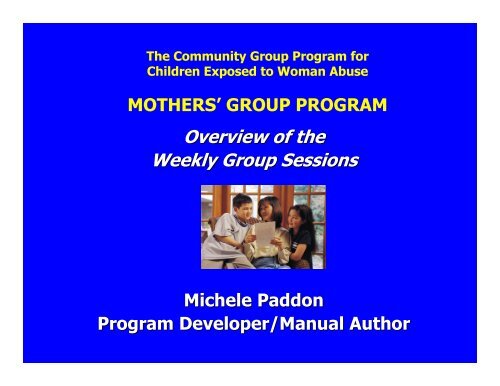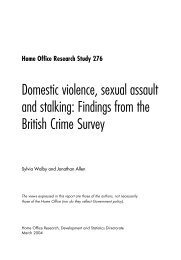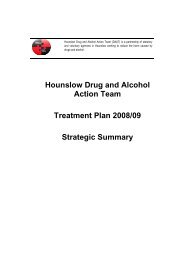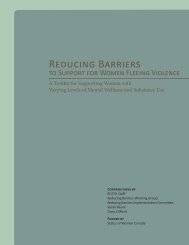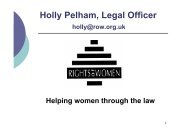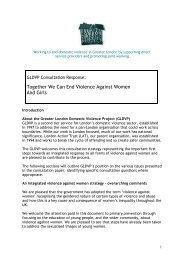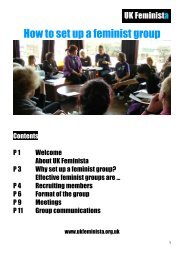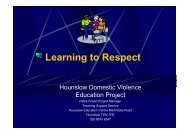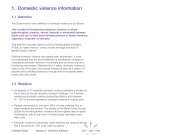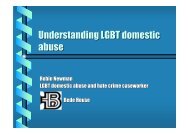MOTHERS’ GROUP PROGRAM Michele Paddon Program Developer/Manual Author
STRATEGIES - AVA
STRATEGIES - AVA
- No tags were found...
Create successful ePaper yourself
Turn your PDF publications into a flip-book with our unique Google optimized e-Paper software.
The Community Group <strong>Program</strong> for<br />
Children Exposed to Woman Abuse<br />
<strong>MOTHERS’</strong> <strong>GROUP</strong> <strong>PROGRAM</strong><br />
Overview of the<br />
Weekly Group Sessions<br />
<strong>Michele</strong> <strong>Paddon</strong><br />
<strong>Program</strong> <strong>Developer</strong>/<strong>Manual</strong> <strong>Author</strong>
SESSION # 1<br />
MOTHER’S <strong>GROUP</strong><br />
Making Connections<br />
CHILDREN’S <strong>GROUP</strong><br />
Getting To Know You
WEEK 1 – MAKING CONNECTIONS<br />
OBJECTIVE:<br />
TRUSTBUILDING<br />
• Decrease isolation, alleviate anxiety, and provide<br />
an overall introduction to the group
STRATEGIES:<br />
Clarify women’s expectations for the group – gain commitment<br />
FLIPCHART #1 FROM <strong>GROUP</strong>:<br />
“Why Are We Here?<br />
Goals For Myself, Goals For My Children”<br />
Clarify role of facilitator in keeping group on track – validate<br />
importance of women’s diverse needs<br />
Begin Community Resource List<br />
Develop Group Rights and Responsibilities<br />
Bridge Gaps & Build Connections – “Paper People”
MOTHER’S S <strong>GROUP</strong><br />
RIGHTS AND RESPONSIBILITIES<br />
• CONFIDENTIALITY<br />
• RESPECT<br />
• PARTICIPATION<br />
• TAKING CARE OF YOURSELF<br />
• BEING ON TIME
Getting To Know You…<br />
• How many children – names, ages?<br />
• Do you work outside of the home?<br />
• How long have you been out of the abusive<br />
situation?<br />
• Where are you from originally?<br />
• Favourite things – colour, food, movie<br />
• Do you have pets?<br />
• If granted 3 wishes, what would you wish for?<br />
• Do you have a nickname?
SESSION # 2<br />
MOTHER’S<br />
<strong>GROUP</strong><br />
• Breaking the<br />
Silence<br />
CHILDREN’S <strong>GROUP</strong><br />
Breaking The Secret<br />
About My Mom’s<br />
Abuse
WEEK 2 – BREAKING THE SILENCE<br />
OBJECTIVE:<br />
SPEAKING OUT ABOUT<br />
ABUSE<br />
• To reduce feelings of isolation by providing<br />
the opportunity for women to begin sharing<br />
stories and experiences of abuse
STRATEGIES:<br />
1) Provide safe opportunities for women to “break the silence” and<br />
talk about the issue of woman abuse from a theoretical point of<br />
view<br />
Broadly identify abuse in 3 areas same process as children’s<br />
group: Physical, Emotional, Sexual<br />
Create a definition for woman abuse – “What Is Woman Abuse?”<br />
2) Support women in beginning to talk about their own personal<br />
experiences of abuse<br />
Emphasize “breaking the silence” as linked to healing / resolution<br />
of trauma<br />
Identify the positive impact for children when mothers begin<br />
“speaking out” . . .<br />
for many children, permission to break the “family secret”
SESSION # 3<br />
MOTHER’S <strong>GROUP</strong><br />
CHILDREN’S <strong>GROUP</strong><br />
The Importance Of<br />
Honouring Our<br />
Many Feelings<br />
How Children Feel<br />
About Abuse That<br />
Happens In<br />
Families
WEEK 3 – THE IMPORTANCE OF ALL<br />
FEELINGS – UNDERSTANDING<br />
THE MESSAGES<br />
OBJECTIVE:<br />
UNDERSTANDING AND<br />
VALUING ALL FEELINGS<br />
• To reinforce the importance of women and<br />
children being able to identify, understand,<br />
and accept all feelings as being valuable -<br />
even the most difficult ones . . .
STRATEGIES:<br />
Provide opportunity for mothers to explore their feelings about<br />
children being exposed to the abuse<br />
INTERACTIVE SAMPLE EXERCISE:<br />
“How I Feel About My Children Being Exposed To<br />
Abuse …”<br />
Support mothers in recognizing how “ice-berging” the difficult<br />
feelings may create a barrier to healing<br />
Identify feelings as an empowering self-awareness tool<br />
Reinforce how children’s ability to experience and express their<br />
own feelings as contingent on mother’s modeling
SESSION # 4<br />
MOTHER’S <strong>GROUP</strong><br />
CHILDREN’S <strong>GROUP</strong><br />
The Impact Of<br />
Being Exposed To<br />
Woman Abuse –<br />
Understanding<br />
Our Children’s<br />
Experiences<br />
“What About Us?”<br />
How Children Feel<br />
About Abuse That<br />
Happens In<br />
Families
WEEK 4 – THE IMPACT OF BEING<br />
EXPOSED TO WOMAN ABUSE –<br />
UNDERSTANDING OUR CHILDREN’S<br />
EXPERIENCES<br />
OBJECTIVE:<br />
REFLECT ON CHILDREN’S<br />
EXPERIENCES OF BEING<br />
EXPOSED TO ABUSE<br />
• For mothers to begin thinking broadly about the<br />
experience and impact of being exposed to<br />
woman abuse on children<br />
• To begin reflecting upon the experiences of their<br />
own children
STRATEGIES:<br />
<br />
<br />
<br />
Plan for “Emotional Self-Care” as women face difficult<br />
feelings evolving from this session<br />
Both children and mothers watch a video during this<br />
session – Video: What About Us?<br />
Safe opportunity for women to think through the eyes of<br />
children – objective through use of video<br />
Support women in beginning to reflect upon and<br />
talking about their own children’s experiences –<br />
Small-Group or Individual Exercise Utilizing<br />
“Iceberg” Analogy – “Through The Eyes Of My<br />
Child”
(TRANSCRIBED FLIPCHART)<br />
WHILE SUPPORTING YOUR CHILDREN IN HEALING<br />
REMEMBER …<br />
YOU are not to blame for your children being<br />
exposed to abuse<br />
The abuser is responsible for choosing to use abuse to gain power<br />
and control over you ~ AND for exposing the children to this<br />
YOU made the best and safest choices for your children<br />
then, and are continuing to do so now…<br />
YOU are keeping your children safe.
SESSION # 5<br />
MOTHER’S <strong>GROUP</strong><br />
Personal Safety<br />
Planning for<br />
Women and<br />
Children<br />
CHILDREN’S <strong>GROUP</strong><br />
Staying Safe When<br />
Abuse Happens –<br />
My Personal Safety<br />
Plan
WEEK 5 – PERSONAL SAFETY PLANNING<br />
FOR WOMEN AND CHILDREN<br />
OBJECTIVE:<br />
TO PROVIDE INFORMATION<br />
ABOUT PERSONAL SAFETY<br />
PLANNING FOR MOTHERS AND<br />
THEIR CHILDREN<br />
• Providing proactive measures towards staying<br />
safe in the case of experiencing or being exposed<br />
to future abuse.
STRATEGIES:<br />
Discuss differences in children’s safety needs as related to<br />
risk and protective factors<br />
Mothers supported in identifying and feeling empowered in<br />
addressing children’s safety needs –<br />
INTERACTIVE SAMPLE EXERCISE:<br />
“Responding to the Physical and Emotional Safety<br />
Needs Of My Children”<br />
Emphasize link between mothers’ and children’s safety<br />
Provide safety planning outlines – Shelternet Version
SESSION # 6<br />
MOTHER’S <strong>GROUP</strong><br />
CHILDREN’S <strong>GROUP</strong><br />
Moving Beyond<br />
Misdirected Blame<br />
– Understanding<br />
Responsibility For<br />
Abuse<br />
Whose Fault Is It<br />
Anyway?<br />
Understanding<br />
Responsibility For<br />
Abuse
WEEK 6 – MOVING BEYOND MISDIRECTED<br />
BLAME – UNDERSTANDING RESPONSIBILITY<br />
FOR ABUSE<br />
OBJECTIVE: CLARIFICATION OF<br />
RESPONSIBILITY FOR<br />
ABUSE<br />
• Examine perceptions about responsibility<br />
from both a mother’s and a child’s<br />
perspective
STRATEGIES:<br />
Discuss how issue of responsibility commonly is one of<br />
the most challenging concepts for women to understand<br />
and reconcile within themselves.<br />
(i.e.) “in my head” versus “in my heart” feelings<br />
Moving from adult-centred thinking to child-centred<br />
thinking –<br />
women rationalizing, misdirecting, internalizing blame for abuse<br />
= barriers to moving forward and healing<br />
HOWEVER for children may = coping<br />
Focus on VALIDATION OF EXPERIENCES through a<br />
variety of exercises –<br />
“The Common Question”, “Why Do Women Stay?”,<br />
“The Power and Control Wheel”
THE COMMON QUESTION . . .<br />
• “Why did she stay?”<br />
• “Why didn’t she leave for the<br />
sake of the children?”<br />
The underlying message?<br />
THE UNCOMMON QUESTION . . .<br />
• “Why did he abuse her?”<br />
• “How could he hurt his<br />
children by being so abusive to<br />
their mother?”<br />
The underlying message?<br />
THE POINT?<br />
Validation –<br />
Helping women see how society imposes thinking that<br />
makes it difficult to leave abusive situations - and that<br />
leaving takes strength, courage, determination
Reasons Women “STAY” in Abusive<br />
Relationships<br />
• I didn’t know where to turn…<br />
• No money to support my family…<br />
• No one will believe me…<br />
• I need to keep my family together…<br />
• My children need a Dad…<br />
• I feel embarrassed, ashamed, maybe this is as good as<br />
it gets…<br />
• Maybe he will change, things will get better…<br />
• I can’t go against my religious beliefs…
THE POWER AND CONTROL WHEEL<br />
• Abusers choose<br />
specific strategies<br />
• Abuse directed at a<br />
specific person<br />
• Abuse taking place at<br />
specific times<br />
• Not random acts, but<br />
repeated behaviour<br />
• Complex, powerful,<br />
dangerous<br />
• Women don’t “stay” –<br />
they resist, comply<br />
and SURVIVE
SESSION # 7<br />
MOTHER’S <strong>GROUP</strong><br />
CHILDREN’S <strong>GROUP</strong><br />
Honouring and<br />
Understanding<br />
Anger:<br />
How To Help<br />
Children Express It<br />
In Healthy Ways<br />
Anger Is Important:<br />
How to Understand<br />
and Express It
WEEK 7 – HONOURING AND<br />
UNDERSTANDING ANGER –<br />
HOW TO HELP CHILDREN EXPRESS IT IN<br />
HEALTHY WAYS<br />
OBJECTIVE:<br />
DIFFERENTIATE BETWEEN<br />
ANGER & ABUSE<br />
• To examine perceptions about anger from the<br />
perspective of mothers and a children who have<br />
experienced abuse<br />
• To identify anger as a valid, powerful, and<br />
appropriate emotion
STRATEGIES:<br />
Discuss the origins of women’s perceptions and feelings<br />
about anger – reclaiming anger as a healthy and mobilizing<br />
emotion<br />
Establish link between the experience of abuse, and<br />
misconceptions about anger –<br />
Group Activity:<br />
“The Difference Between Anger and Abuse”<br />
Support women in redefining anger in healthy ways<br />
Explore ways mothers can support children in understanding<br />
their experience of anger, and how to express it in healthy<br />
ways –<br />
“What Mothers Want Children To Think About Anger”
The powerful outcome of this exercise is that often in the midst of<br />
engaging in it, you clearly see women suddenly shifting and<br />
“getting it” . . .<br />
women themselves quickly see how they interchange their<br />
perceptions of anger and abuse<br />
ANGER<br />
• Hostility<br />
• Fear<br />
• Breaking things<br />
• A fight<br />
• Unpredictable<br />
• Out of control<br />
• Dangerous<br />
ABUSE<br />
• Hostility<br />
• Fear Inducing<br />
• Power Over<br />
• Out of control<br />
• Anxiety Provoking<br />
• Damaging<br />
• Dangerous
(TRANSCRIBED FLIPCHART)<br />
What do we want children to<br />
think about anger?<br />
It is okay to feel anger<br />
Anger is healthy and necessary<br />
Anger can help us identify solutions to problems<br />
A DEFINITION OF ANGER FOR OUR CHILDREN:<br />
Anger is an expression of strong emotion<br />
that relates to a problem that needs to be<br />
solved…
SESSION # 8<br />
MOTHER’S <strong>GROUP</strong><br />
CHILDREN’S <strong>GROUP</strong><br />
Understanding<br />
Conflict –<br />
Guiding Children<br />
To Solve Problems<br />
Helpful, Not<br />
Hurtful Ways<br />
Solving Problems In<br />
Helpful, Not Hurtful<br />
Ways
WEEK 8 – UNDERSTANDING CONFLICT<br />
– GUIDING CHILDREN TO SOLVE<br />
PROBLEMS IN HELPFUL,<br />
NOT HURTFUL WAYS<br />
OBJECTIVE:<br />
POSITIVE<br />
CONFLICT<br />
RESOLUTION<br />
• To explore how experiences of abuse have<br />
shaped women’s and children’s attitudes<br />
and beliefs about conflict in relationships<br />
• To recognize conflict as a normal part of all<br />
relationships
STRATEGIES:<br />
Identify conflict as a natural part of relationships<br />
- does not inevitably lead to abuse<br />
- importance of conveying this message to children.<br />
Provide mothers with a self assessment tool for reframing &<br />
responding to conflict with children –<br />
INTERACTIVE SAMPLE EXERCISE:<br />
“Responding To Conflict – The Connection Between Thoughts,<br />
Feelings, and Actions”<br />
Discuss how a mothers can reframe conflict in a positive way<br />
for children<br />
- Differentiate between responding vs. reacting to conflict<br />
problem-solving vs. abuse<br />
- Provide a practical conflict resolution framework for use<br />
with children –<br />
“Children’s Problem-Solving Framework”
“When my child tries to solve problems<br />
by using aggression . . .”<br />
FEELINGS<br />
FEELINGS . . .<br />
• Confused<br />
• Overwhelmed<br />
• Angry<br />
• Scared<br />
• Powerless<br />
• Discouraged<br />
• Hurt<br />
• Furious
“When my child tries to solve problems<br />
by using aggression . . .”<br />
THOUGHTS<br />
THOUGHTS . . .<br />
“My child is going to be an abuser!”<br />
“This is just like my abusive<br />
relationship – I won’t put up<br />
with it!”<br />
“I should have left sooner – now look<br />
what I’ve done . . .”<br />
“How can she act this way - she<br />
knows we left to get away from<br />
this!”
“When my child tries to solve problems<br />
by using aggression . . .”<br />
ACTIONS . . .<br />
• I would physically intervene<br />
• I would yell for her to stop<br />
• I would do nothing, it’s my<br />
fault anyway<br />
ACTIONS<br />
• I would be very upset and<br />
emotional<br />
• I would ask why he was<br />
acting just like his father
PROBLEM-SOLVING<br />
• STEP 1<br />
• STEP 2<br />
• STEP 3<br />
• STEP 4<br />
• STEP 5<br />
What is the problem?<br />
What are some solutions?<br />
For each solution ask:<br />
- How might people feel?<br />
- Is it fair?<br />
- Will it work?<br />
Choose and use a solution<br />
Is it working? If not – what now?
SESSION # 9<br />
MOTHER’S <strong>GROUP</strong><br />
CHILDREN’S <strong>GROUP</strong><br />
Grieving The Losses<br />
– Celebrating<br />
Choices and<br />
Change!<br />
Dealing With Family<br />
Changes
WEEK 9 – GRIEVING THE LOSSES –<br />
CELEBRATING CHOICES AND CHANGE!<br />
OBJECTIVE: Validate importance of the<br />
grieving process<br />
To validate the difficulties and barriers women and<br />
children face related to change and loss after<br />
leaving abusive situations
STRATEGIES:<br />
Validate the need to grieve losses and changes after<br />
leaving an abusive situation<br />
- Discuss the barriers to grieving the losses –<br />
personal & societal<br />
Promote balance through identifying BOTH losses and<br />
gains experienced by children and their mothers –<br />
Exercise: “What We Have Lost/What Has Changed –<br />
What We Have Gained/ How Things Are Better”<br />
Support mothers in understanding and responding to<br />
children’s challenging behaviours related to loss and change
LOSSES AND GAINS<br />
LOSSES/CHANGES<br />
• Husband / Partner / DAD<br />
• My Stuff – Kids’ Toys<br />
• Relatives<br />
• My Job<br />
• Our home – had to move<br />
• Kids had to change schools<br />
• Lost friends<br />
• Pets<br />
• Money<br />
• The “dream”<br />
GAINS/HOW THINGS<br />
ARE BETTER<br />
• Freedom<br />
• My family feels safer<br />
• Self esteem up for all<br />
• My children more secure –<br />
believe I can take care of<br />
myself and them<br />
• I can live without constant<br />
fear<br />
• New friends<br />
• NEW DREAMS!
SESSION # 10<br />
MOTHER’S <strong>GROUP</strong><br />
CHILDREN’S <strong>GROUP</strong><br />
Staying Connected:<br />
How and Where to Get<br />
What I Need from<br />
Community<br />
Resources<br />
Staying Safe From<br />
All Kinds of Abuse:<br />
Sexual Abuse<br />
Prevention<br />
Or<br />
Acquaintance Abuse<br />
Prevention Strategies
WEEK 10 – STAYING CONNECTED –<br />
HOW AND WHERE TO GET WHAT I<br />
NEED FROM COMMUNITY RESOURCES<br />
OBJECTIVE:<br />
Decrease isolation through<br />
increasing women’s awareness<br />
of how to develop a support<br />
network and access<br />
community resources
STRATEGIES:<br />
Reinforce of avoiding isolation as KEY to staying safe<br />
from future abuse<br />
Create a concrete support link through introduction to<br />
women’s advocates in the community –<br />
Guest Speaker for the group session<br />
Provide information about resources in the community<br />
for mothers and children –<br />
Provide copies of women’s own community<br />
resource list<br />
Discuss the concept of a developing a personal support<br />
network as link to avoiding isolation –<br />
INTERACTIVE SAMPLE EXERCISE:<br />
“My Support Tree”
SESSION # 11<br />
MOTHER’S <strong>GROUP</strong><br />
CHILDREN’S <strong>GROUP</strong><br />
The Importance Of<br />
Self Care While<br />
Mothers and their<br />
Children Heal From<br />
The Impact Of<br />
Abuse<br />
All The Wonderful<br />
Things About Me!
WEEK 11 – THE IMPORTANCE OF SELF<br />
CARE WHILE MOMS AND KIDS HEAL<br />
FROM THE IMPACT OF ABUSE<br />
OBJECTIVE:<br />
Support women in defining and<br />
understanding the importance<br />
of self-care
STRATEGIES:<br />
Discuss the importance of self-care in relation to ongoing<br />
healing from the impact of abuse<br />
- Identify and validate the barriers to self-care while in an<br />
abusive relationship<br />
- Identify how practicing healthy self-care has a positive impact<br />
on children<br />
Discuss women’s ideas about self-care and strategies for<br />
overcoming the barriers – Exercises:<br />
“Self Care – What I’d Like To Do & Why I Don’t – How To Make<br />
It Happen”<br />
“Checking my Basic Needs” – Self Care Checklist / Inventory<br />
Discuss the importance of balance through a holistic approach<br />
to self-care – Exercise:<br />
Physical, Emotional, and Spiritual Self Care
Balancing Physical, Emotional, and<br />
Spiritual Self Care<br />
Physical<br />
• Physical – taking care of<br />
one’s body<br />
Spiritual<br />
Emotional<br />
• Emotional – taking care<br />
of one’s feelings,<br />
emotional well-being<br />
• Spiritual – taking care of<br />
one’s spirit, having hope<br />
for the future, feeling<br />
positive about personal<br />
choices, peace of mind
SESSION # 12<br />
MOTHER’S <strong>GROUP</strong><br />
CHILDREN’S <strong>GROUP</strong><br />
Celebrating How Far<br />
We’ve Come –<br />
Moving Onward<br />
Celebrating Our Time<br />
Together - Saying<br />
“Good Bye”
WEEK 12 – CELEBRATING HOW FAR<br />
WE’VE COME – MOVING ONWARD<br />
OBJECTIVE:<br />
Support women in<br />
celebrating their<br />
time together, and<br />
saying goodbye.
STRATEGIES:<br />
Support women in feeling validated about the<br />
importance of celebrating their time together, and<br />
having a sense of closure to the group.<br />
Celebration personalized by women & supported by<br />
group facilitators<br />
Facilitators to lead symbolic closure activities such as :<br />
o “Affirmations / Celebrating Women’s Strengths”<br />
Collage”<br />
o “Taking Back My Life” Exercise<br />
o “Recognition Ceremony”
TAKING BACK MY LIFE!<br />
To Do List<br />
To Avoid List<br />
• Stay Connected With<br />
Other Women<br />
• Go to another group<br />
• Take care of myself<br />
every day<br />
• Get out of the house<br />
• Recognize the “red<br />
flags” of abuse<br />
• Remember how far<br />
I’ve come!<br />
• Abusers!<br />
• Getting isolated<br />
• Unsupportive people<br />
• “Should-ing” on<br />
myself<br />
• The bar scene, or<br />
other “danger” places
<strong>Michele</strong> <strong>Paddon</strong><br />
<strong>Program</strong> <strong>Developer</strong> / <strong>Manual</strong> <strong>Author</strong><br />
<strong>Michele</strong> <strong>Paddon</strong><br />
c/o Changing Ways:<br />
825 Bradley Avenue<br />
London, Ontario<br />
Canada<br />
N6E 3C2<br />
(519)438-9869 x224<br />
michelep@changingways.on.ca<br />
www.changingways.on.ca


